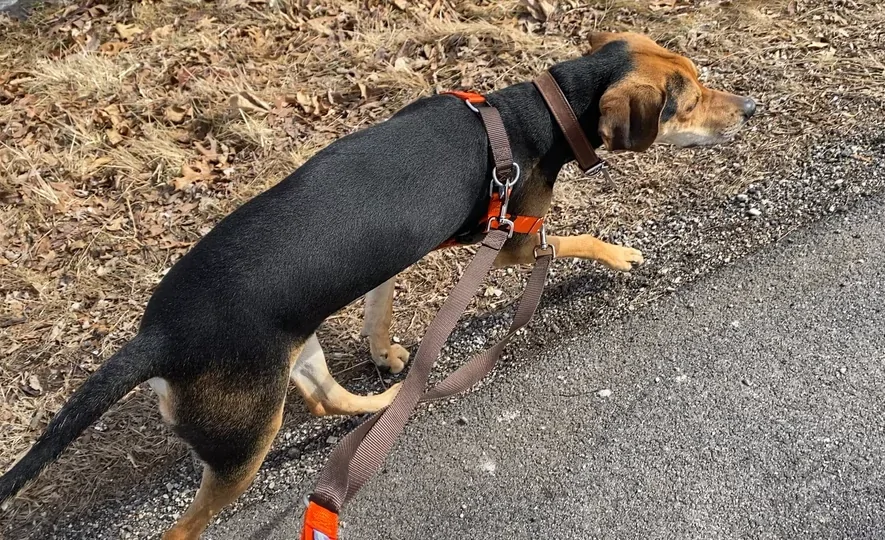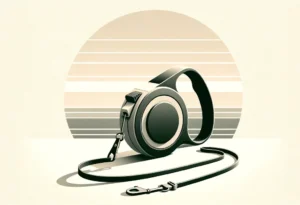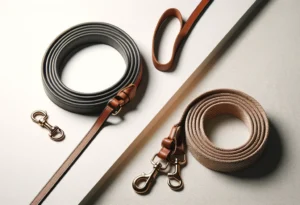Disclosure: We may earn a commission from helpful, relevant links in our content. No cost to you. See our privacy policy.
Just the other day, I was taking my good ol’ Sam for a walk, feeling pretty confident with our new training leash—until it snapped, sending him on an impromptu squirrel-chasing adventure.
Talk about a heart-stopping moment! If you’ve ever experienced the panic of a leash mishap or struggled to find the right one to help you train your furry friend, this blog post is for you.
Together, we’ll explore the ins and outs of selecting the perfect dog training leash, so you can avoid those unexpected mishaps and confidently lead your pup to success.
Related dog training gear guides:
Picking the Perfect Dog Training Collar
Choosing the Right Dog Training Harness
Top Clickers for Dog Training

Why Choosing the Right Leash Matters
A great training leash isn’t just about keeping your dog close—it’s an essential tool to help you communicate effectively with your canine friend.
Choosing the right leash can make a world of difference in your dog’s responsiveness and overall training progress.
A well-suited leash allows you to guide your dog gently, maintain control during training sessions, and, most importantly, keep both you and your furry friend safe.
So, as we dive into the world of dog training leashes, remember that making a thoughtful choice is the first step toward a well-behaved, happy pup!
Types of Training Leashes: Pros and Cons
Standard Flat Leash
The standard flat leash is the classic go-to for most dog owners. Made from a variety of materials such as nylon, leather, or rope, these leashes are simple and straightforward, with a clip on one end and a handle on the other. They typically range from 4 to 6 feet in length.
Pros:
- Easy to use and widely available
- Comes in various materials, colors, and lengths
- Suitable for dogs of all sizes and breeds
Cons:
- Limited control in certain training situations
- Not ideal for dogs who tend to pull or lunge
The Blueberry Pet Essentials Classic Dog Leash (image below) is a great choice for casual walks and basic obedience training, providing durability and reliability in a simple design. Its sturdy construction and various color options make it a fantastic starting point for any dog owner.

When I first started training Sam, I used a standard flat leash made of durable nylon. It was perfect for our casual walks and basic obedience training, but as we progressed, I realized we needed something more specialized for advanced exercises.

Slip Leash
A slip leash, also known as a slip lead or choke collar, is a single piece of rope or webbing that loops around the dog’s neck and tightens when pulled. This design allows for quick and gentle corrections during training sessions.
Pros:
- Offers increased control during training
- Can be easily put on and taken off
- Discourages pulling
Cons:
- Potential for injury if not used correctly
- Not suitable for dogs with respiratory issues or delicate tracheas

The Mendota Products Slip Lead (image above) is an excellent option for a leash that provides gentle control and prevents pulling. Its easy on/off design, combined with its high-quality construction, makes it perfect for quick walks or training sessions.
Adjustable Leash
An adjustable leash, as the name suggests, can be modified in length to suit various training scenarios. It typically has multiple D-rings along its length and a clip that attaches to the rings, allowing you to create a customized fit.
Pros:
- Versatile and adaptable for different situations
- Can be used as a hands-free leash
- Works well for dogs at various stages of training
Cons:
- May be more complex to use for beginners
- Can be more expensive than standard leashes

For versatile training and various exercises, the Halti Training Lead (image above) is a great example of this type of leash. With its ability to adjust length easily and its double-ended design, you’ll find it’s a valuable tool in your training toolkit.
Long Line Leash
A long line leash, or training lead, is an extended leash that can range from 15 to 100 feet in length. It is primarily used for distance training, recall exercises, and allowing your dog some freedom while maintaining control.
Pros:
- Provides ample room for your dog to explore
- Ideal for recall and off-leash training
- Allows for a controlled introduction to off-leash activities
Cons:
- Can be difficult to manage due to its length
- Not suitable for everyday walks or crowded environments
After trying out different leash options, I found that using an adjustable leash combined with a long line leash for specific training exercises worked best for Sam and me.
This combination allowed me to easily switch between close control and giving Sam the freedom to roam during training sessions. As a result, Sam’s recall improved significantly, and our bond grew stronger as we mastered advanced exercises together.

When it comes to distance training and recall exercises, the Hi Kiss Dog/Puppy Obedience Recall Training Agility Lead (image above) is a great choice. Its extended length and bright color options allow for controlled exploration and a gradual introduction to off-leash activities.
Here’s a table illustrating these types of leashes, what they are best used for, with some of the suggested products:
| Leash Type | Most Suitable For | Recommended Product |
| Standard Flat Leash | Casual walks, basic obedience training | Blueberry Pet Essentials Classic Dog Leash |
| Slip Leash | Training dogs not to pull, quick on/off use | Mendota Products Slip Lead |
| Adjustable Leash | Versatility, various training exercises | Halti Training Lead |
| Long Line Leash | Distance training, recall exercises | Hi Kiss Dog/Puppy Obedience Recall Training Agility Lead |
Remember, it’s important to find the right leash for your dog’s unique needs, so don’t be afraid to experiment and see what works best for your training goals. For a complete guide on choosing training collars, go here.

How to Choose the Best Leash for Your Dog
Consider Your Dog’s Size and Strength
The first thing you’ll want to think about is the size and strength of your dog. A small, lightweight leash may be perfect for a petite pup, but it might not hold up to the power of a large, energetic dog.
Similarly, a thick, heavy leash could be too cumbersome for smaller breeds. Choose a leash that’s appropriate for your dog’s size to ensure safety and durability.
Here are suggested leash types based on the dog’s size and strength:
| Dog’s Size/Strength | Suggested Leash Type | Reason for Suggestion |
| Small/Petite | Lightweight Flat Leash | Easy for small dogs to handle |
| Large/Energetic | Durable Flat Leash, Rope Leash | Strong and secure for powerful dogs |
Evaluate Your Training Goals
What do you hope to achieve in your training sessions? Are you working on basic obedience, advanced commands, or off-leash recall? Your training goals will help determine the type of leash you need.
For instance, a standard flat leash is great for everyday use and basic training, while a long line leash is ideal for recall exercises and distance work.
Here’s are suggested leash types based on your training goals:
| Training Goals | Suggested Leash Type | Reason for Suggestion |
| Basic Obedience | Standard Flat Leash | Good for everyday use and basic training |
| Advanced Commands | Adjustable Leash | Versatile for advanced training exercises |
| Off-leash Recall | Long Line Leash | Ideal for recall exercises and distance work |
Think About Your Environment
Take into account the surroundings where you’ll be walking and training your dog. If you live in a busy urban area, you may want a shorter, more easily controlled leash to navigate crowded sidewalks.
On the other hand, if you have access to open fields or quiet parks, a longer leash might be a better fit for your dog’s exploration and training needs.
Here are the suggested leash types based on the training environment:
| Training Environment | Suggested Leash Type | Reason for Suggestion |
| Busy Urban Area | Short Flat Leash, Slip Leash | Provides better control in crowded spaces |
| Open Fields/Parks | Long Line Leash | Allows for exploration and training in open spaces |
Prioritize Comfort and Ease of Use
A comfortable, easy-to-handle leash will make your training sessions more enjoyable and productive for both you and your dog. Look for features such as padded handles, ergonomic design, and easy-to-clip hardware.
When I was testing leashes for Sam, I found that a leash with a padded handle made a significant difference in my comfort during our long walks and training sessions.
Here’s a table of suggested leashes based on the comfort and ease of use:
| Comfort Feature | Suggested Leash Type | Reason for Suggestion |
| Padded Handle | Padded Flat Leash | Reduces discomfort during long walks and training sessions |
| Ergonomic Design | Ergonomic Leash | Designed for ease of use and comfort |
Don’t Forget the Material
Lastly, consider the material of the leash. Each material has its pros and cons, so think about your preferences and your dog’s habits.
Nylon is lightweight, affordable, and available in many colors, but it can be less durable and uncomfortable to hold if your dog pulls.
Leather is strong, comfortable, and long-lasting, but it may require more maintenance and can be more expensive. Rope leashes are often sturdy and provide a secure grip, but they may be bulkier than other options.
By carefully considering these factors, you’ll be able to find the perfect training leash for your dog. And remember, just as I found with Sam, sometimes a combination of leashes is the best solution to meet your various training needs. Happy training!

What Training Exercises Require Specific Leashes?
Recall Training
Recall training is essential for teaching your dog to come back to you when called, and a long line leash is the perfect tool for this exercise. It provides your dog with the freedom to explore while still allowing you to maintain control, making it an excellent choice for building trust and practicing off-leash skills.
When I first started recall training with Sam, we used a 30-foot long line leash, which gave him enough space to roam while allowing me to reel him in if needed.
Loose Leash Walking
Loose leash walking is a critical skill that helps prevent pulling and ensures pleasant walks for both you and your dog. A standard flat leash or an adjustable leash works well for this type of training.
The flat leash provides consistency, while an adjustable leash can offer varying lengths for different training situations, such as walking in a crowded area or practicing heel commands.
Agility Training
Agility training, which includes navigating obstacles and jumps, typically requires a leash that provides maximum freedom of movement.
A slip leash or a short, lightweight standard leash is ideal for this type of exercise, as it allows your dog to move easily without the leash getting in the way.
Tips for Safe and Effective Leash Training
Leash training is an essential skill for both you and your dog to master. The following tips will help you create a positive training experience, ensuring both safety and effectiveness during your sessions:
- Be Patient and Consistent. Training takes time, so be patient with your dog as they learn new skills. Consistency is key, so try to practice regularly and use the same commands and techniques to help your dog understand what’s expected of them.
- Use Positive Reinforcement. Reward your dog with praise, treats, or toys when they respond correctly to a command or display good leash manners. This positive reinforcement helps your dog associate proper behavior with rewards, making them more likely to repeat the behavior in the future.
- Start in a Low-Distraction Environment. Begin your leash training in a quiet, low-distraction setting, such as your backyard or a quiet park. As your dog becomes more comfortable and skilled, gradually introduce more distractions and challenges.
- Monitor Your Dog’s Body Language. Pay attention to your dog’s body language to understand their needs and comfort levels during training sessions. If they seem stressed or overwhelmed, take a break and try again later.
One amusing experience I had with Sam during our loose leash training involved a squirrel. We were practicing in our backyard when a squirrel appeared, and Sam couldn’t resist the urge to chase it.
The adjustable leash we were using allowed me to quickly shorten it, preventing him from taking off after the squirrel. I then redirected his attention with a treat, and we resumed our training. It was a valuable lesson in adapting to unexpected distractions and maintaining control even in exciting situations.
Suggested read: Training aids for leash pulling
Leash Maintenance and Care
To keep your dog’s leash in top condition, regularly inspect it for signs of wear and tear, such as fraying or damaged hardware.
Clean the leash as needed, following the manufacturer’s guidelines—most standard leashes can be hand-washed with mild soap and water, while others may require special care.
When To Upgrade Your Leash?
It’s time to upgrade your dog’s leash when you notice excessive wear, fraying, or damaged hardware that could compromise its safety and effectiveness.
Additionally, if your dog’s training needs or size have changed, you may want to consider a different type of leash. I remember when Sam grew out of his puppy stage, and we had to switch from a lightweight leash to a more durable one that could better handle his increased strength.
You may be in a similar situation, in which case a new leash is needed. If you’ve selected your new leash, you can move on to Positive reinforcement and Basic obedience training from our guides.
Here’s a video on how to get started with leash training:
FAQs
How do I know if a leash is the right length for my dog?
A leash should be long enough to allow your dog some freedom to explore but short enough to maintain control. For most dogs, a 4- to 6-foot leash is a suitable length for walking and basic training.
Are retractable leashes suitable for training?
Retractable leashes are generally not recommended for training, as they can encourage pulling and make it difficult to maintain consistent tension or control during training exercises. Refer above to our guide on how to choose a better option for your training needs.
Can I use a harness with a training leash?
Yes, you can use a harness with a training leash. In fact, a harness can provide better control and reduce strain on your dog’s neck during training, especially for dogs that tend to pull.
How often should I replace my dog’s training leash?
The frequency of replacing your dog’s training leash depends on the leash’s material, quality, and usage. Regularly inspect the leash for wear and tear, and replace it when it shows signs of damage or compromised safety.
Alex, a passionate animal lover, has experience in training and understanding animal behavior. As a proud pet parent to two dogs and three cats, he founded AnimalReport.net to share insights from animal experts and expand his knowledge of the animal kingdom.




